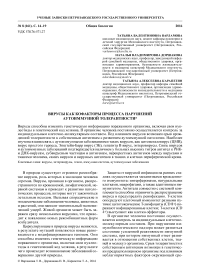Вирусы как кофакторы процесса нарушений аутоиммунной толерантности
Автор: Варламова Татьяна Валентиновна, Доршакова Наталья Владимировна, Карапетян Татьяна Алексеевна
Журнал: Ученые записки Петрозаводского государственного университета @uchzap-petrsu
Рубрика: Биология
Статья в выпуске: 8 (161), 2016 года.
Бесплатный доступ
Вирусы способны изменять генетическую информацию пораженного организма, включая свои нуклеотиды в генетический код хозяина. В организме человека постоянно осуществляется контроль за индивидуальным клеточно-молекулярным составом. Под влиянием вирусов возможен срыв врожденной толерантности к собственным антигенам с развитием аутоиммунной патологии. Наиболее изучена взаимосвязь с аутоиммунными заболеваниями таких вирусов, как цитомегаловирус (ЦМВ), вирус простого герпеса, Эпштейн-Барр вирус (ЭБ), гепатита В вирус, энтеровирусы. Связь вирусов и аутоиммунных заболеваний подтверждается наличием у больных высоких титров антител к РНК-и ДНК-вирусам, субвирусным частицам и антигенам, перекрестных антигенов между вирусами и тканями человека, самих вирусов и вирусных антигенов в тканях и клетках периферической крови.
Вирусы, энтеровирусы, геном, иммунная система, аутоиммунные заболевания
Короткий адрес: https://sciup.org/14751120
IDR: 14751120
Список литературы Вирусы как кофакторы процесса нарушений аутоиммунной толерантности
- Харлашина Е. А., Шаповальянц О. С. Дебют сахарного диабета 1 типа на фоне инфекционного мононуклеоза//Сахарный диабет. 2010. № 1. С. 126-128.
- Awa W. L., Boehm B. O., Kapellen T., Rami B., Rupprath P., Marg W., Becker M., Holl R. W. HLA-DR genotypes influence age at disease onset in children and juveniles with type 1 diabetes mellitus//Eur. J. Endocrinol. 2010. Vol. 163. № 1. P. 97-104.
- Bach J. F. Infections and autoimmune diseases//J. Autoimmun. 2005. Vol. 25. P. 74-80.
- Bibbо S., Dore M. P., Pes G. M., Delitala G., Delitala A. P. Is there a role for gut microbiota in type 1 diabetes pathogenesis?//Ann. Med. 2016. № 8. P. 1-25.
- Bjornvold M., Und lien D. E., Joner G., Dahl-Jorgensen K., Njolstad P. R., Akselsen H. E., Gervin K., Ronningen K. S., Stene L. C. Joint effects of HLA, INS, PTPN22 and CTLA4 genes on the risk of type 1 diabetes//Diabetologia. 2008. Vol. 51. № 4. P. 589-596.
- Cinek O., Wits0 E., Jeansson S., Rasmussen T., Drevinek P., Wetlesen T., Vavrinec J., Grinde B., R0nningen K. S. Longitudinal observation of enterovirus and adenovirus in stool samples from Norwegian infants with the highest genetic risk of type 1 diabetes//J. Clin. Virol. 2006. Vol. 35. № 1. P. 33-40.
- Green J., Casabonne D., Newton R. Coxsackie B virus serology and Type 1 diabetes mellitus: a systematic review of published case-control studies//Diabet. Med. 2004. Vol. 21. № 6. P. 507-514.
- Hyoty H., Taylor K. W. The role of viruses in human diabetes//Diabetologia. 2002. Vol. 45. P. 1353-1361.
- Hyöty H. Viruses in type 1 diabetes//Pediatr. Diabetes. 2016. Vol. 17. P. 56-64.
- Kerr J. R. The role of parvovirus B19 in the pathogenesis of autoimmunity and autoimmune disease//J. Clin. Pathol. 2016. Vol. 69. № 4. P. 279-291.
- Kim K. W., Ho A., Alshabee-Akil A., Hardikar A. A., Kay T. W., Rawlinson W. D., Craig M. E. Coxsackievirus B5 Infection Induces Dysregulation of microRNAs Predicted to Target Known Type 1 Diabetes Risk Genes in Human Pancreatic Islets//Diabetes. 2016. Vol. 65. № 4. P. 996-1003.
- Knip M., Hyöty H., Dabelea D., Klingensmith G. J. Environmental determinants: The role of viruses and standard of hygiene//Epidemiology of Pediatric and Adolescent Diabetes. 2008. P. 63-64.
- Kondrashova A., Nurminen N., Patrikainen M., Huhtala H., Lehtonen J., Toppari J., Ilonen J., Simell O. G., Veijola R., Knip M., Hyöty H. Influenza A virus antibodies show no association with pancreatic islet autoantibodies in children genetically predisposed to type 1 diabetes//Diabetologia. 2015. Vol. 58. № 11. P. 2592-2595.
- Larsson H. E., Lynch K., Lernmark B., Nilsson A., Hansson G., Almgren P., Lernmark A. Diabetes-associated HLA genotypes affect birthweight in the general population//Diabetologia. 2005. Vol. 48. № 8. P. 1484-1491.
- Lönnrot M., Knip M., Roivainen M., Koskela P., Akerblom H. K., Hyöty H. Onset of type 1 diabetes mellitus in infancy after enterovirus infections//Diabet. Med. 1998. Vol. 15. № 5. P. 431-434.
- Massilamany C., Koenig A., Reddy J., Huber S., Buskiewicz I. Autoimmunity in picornavirus infections//Curr. Opin. Virol. 2016. Vol. 16. P. 8-14.
- Nairn C., Galbraith D. N., Taylor K. W., Clements G. B. Enterovirus variants in the serum of children at the onset of Type 1 diabetes mellitus//Diabet. Med. 1999. Vol. 16. № 6. P. 509-513.
- Nurminen N., Oikarinen S., Hyöty H. Virus infections as potential targets of preventive treatments for type 1 diabetes//Rev. Diabet Stud. 2012. Vol. 9. № 4. P. 260-271.
- Oikarinen M., Tauriainen S., Honkanen T. Detection of enteroviruses in intenstine of type 1 diabetic patients//Clin. Exp. Immunol. 2008. Vol. 151. P. 71-75.
- Rodriguez-Calvo T., Sabouri S., Anquetil F., von Herrath M. G. The viral paradigm in type 1 diabetes: Who are the main suspects?//Autoimmun. Rev. 2016 Vol. 15. № 10. P. 964-969.
- Smith C. P., Clements G. B., Riding M. H., Collins P., B o tt az z o G. F., Taylor K. W. Simultaneous onset of type 1 diabetes mellitus in identical infant twins with enterovirus infection//Diabet. Med. 1998. Vol. 15. № 6. P. 515-517.
- Tauriainen S., Oikarinen S., Oikarinen M., Hyöty H. Enteroviruses in the pathogenesis of type 1 diabetes//Semin. Immunopathol. 2011. Vol. 33. P. 45-55.
- Yeung W. C., Rawlinson W. D., Craig M. Enterovirus infection and type 1 diabetes mellitus: Systematic review and meta-analysis of observational molecular studies//B. M. J. 2011. Vol. 342. P. 35.
- Viskari H., Ludvigsson J., Uibo R., Salur L., Marciulionyte D., Hermann R., Soltesz G., Füchtenbusch M., Ziegler A. G., Kondrashova A., Romanov A., Knip M., Hyöty H. Relationship between the incidence of type 1 diabetes and enterovirus infections in different European populations: results from the EPIVIR project//J. Med. Virol. 2004. Vol. 72. № 4. P. 610-617.


